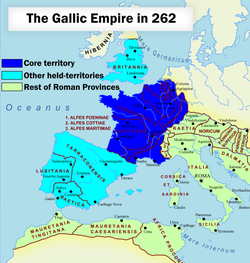
Back إمبراطورية الغال Arabic Qalliya imperiyası Azerbaijani Гальская імперыя Byelorussian Галска империя Bulgarian Impalaeriezh c'halian Breton Imperi de les Gàl·lies Catalan Galské císařství Czech Yr Ymerodraeth Alaidd Welsh Gallisches Sonderreich German Γαλατική Αυτοκρατορία Greek
Gallic Empire | |||||||||
|---|---|---|---|---|---|---|---|---|---|
| 260–274 | |||||||||
 The Gallic Empire under Postumus by 262 (in blue), with the Roman Empire. | |||||||||
| Capital |
| ||||||||
| Common languages |
| ||||||||
| Government | Autocracy | ||||||||
| Emperor | |||||||||
• 260–269 | Postumus | ||||||||
• 269 | Marius | ||||||||
• 269–270 | Victorinus | ||||||||
• 270–274 | Tetricus I | ||||||||
| Historical era | Late Antiquity | ||||||||
• Established | 260 | ||||||||
| 274 | |||||||||
| |||||||||
The Gallic Empire[a] or the Gallic Roman Empire are names used in modern historiography for a breakaway part of the Roman Empire that functioned de facto as a separate state from 260 to 274.[b] It originated during the Crisis of the Third Century, when a series of Roman military leaders and aristocrats declared themselves emperors and took control of Gaul and adjacent provinces without attempting to conquer Italy or otherwise seize the central Roman administrative apparatus.[7]
The Gallic Empire was established by Postumus in 260 in the wake of barbarian invasions and instability in Rome, and at its height included the territories of Germania, Gaul, Britannia, and (for a time) Hispania. After Postumus' assassination in 269 it lost much of its territory, but continued under a number of emperors and usurpers. It was retaken by Roman emperor Aurelian after the Battle of Châlons in 274.
- ^ Bourne, R. J. (2001). Aspects of the relationship between the Central and Gallic Empires in the mid to late third century AD with special reference to coinage studies. Archaeopress. p. 22.
- ^ Drinkwater 1987, pp. 126–127.
- ^ Drinkwater 1987, p. 15.
- ^ Polfer (Postumus)
- ^ Drinkwater 1987, p. 97.
- ^ Drinkwater 1987, pp. 95–106.
- ^ Goldsworthy, Adrian (2009). The Fall of the West. Weidenfeld & Nicolson. pp. 116–117.
Cite error: There are <ref group=lower-alpha> tags or {{efn}} templates on this page, but the references will not show without a {{reflist|group=lower-alpha}} template or {{notelist}} template (see the help page).